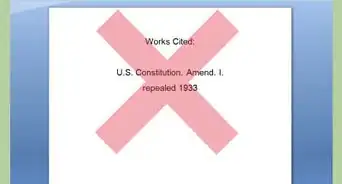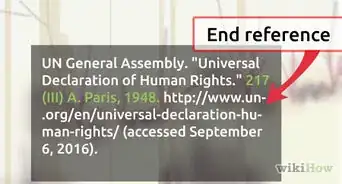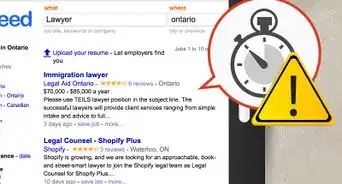This article was co-authored by Clinton M. Sandvick, JD, PhD. Clinton M. Sandvick worked as a civil litigator in California for over 7 years. He received his JD from the University of Wisconsin-Madison in 1998 and his PhD in American History from the University of Oregon in 2013.
This article has been viewed 115,825 times.
The common law term “ratio decidendi” is Latin for the “reason for the decision” or the rule of a case. Every decision that an appellate court makes governs the future decisions of trial courts. In other words, the lower courts must follow the rules that the appellate court states in its written decisions. When the lower court encounters a certain situation or legal dispute, it will look to appellate court opinions that deal with similar situations for guidance.
Steps
Understanding Precedent
-
1Define precedent generally. This term refers to an action that happened or something that was done in the past, which serves as a model or guidance for future actions. If you encounter a certain situation, you would look to precedent – or how the situation was handled in the past - in order to handle that situation at the present time. For instance, suppose that you ground your oldest child for two weeks for getting a “D” on his report card. A year later, when your middle child receives a “D” on her report card, you would look to precedent to know how long to ground her. Since your oldest child was grounded for two weeks, then your middle child also should be grounded for two weeks for the same behavior.
-
2Define precedent in the legal sense. A precedent is a decision by a judge or a panel of judges that is binding on, or governs, lower courts in the same jurisdiction. It establishes a rule of law, or “ratio decidendi,” that other courts must follow. When one of the lower courts has a case involving the same or similar facts as a precedent, the court must follow the precedent. In the case of the ratio decidendi, the precedent set is the principle or reasoning that has been established in a single case that serves as an example or rule to be followed in subsequent cases.[1]
- A precedent also may be referred to as the “holding” of a case.
- Typically, an appellate court establishes precedent. This could be a U.S. Court of Appeals, the U.S. Supreme Court, or a state appeals or supreme court. However, courts can also look to other equivalent courts for precedent. For instance, the U.S. District Court for the Southern District of Indiana might look to the U.S. District Court for the Northern District of Indiana for precedent in some cases.
- The other meaning of precedent in law refers to a model document or clause that a lawyer bases the drafting of clauses, contracts, agreements, etc. from.
Advertisement -
3Understand the difference between binding and nonbinding precedent. Some court decisions are binding on courts, meaning that a court has to follow those decisions. This is the case, for example, if the U.S. Supreme Court establishes a rule on a particular point of law. Any lower courts, such as a U.S. Court of Appeals, must follow the U.S. Supreme Court decision. Non-binding precedent involves decisions by equivalent courts. The U.S. Court of Appeals for the 1st Circuit might look at how the U.S. Court of Appeals for the 9th Circuit has ruled on a particular case as nonbinding precedent. It can follow the other court’s decision, or not; it is not required to follow the other court’s ruling because it is not binding precedent.[2]
-
4Understand stare decisis. Stare decisis translates to "let the decision stand". This means courts considering a certain kind of case generally have to follow the rulings in previous court cases. It also helps people know what to expect when faced with certain legal issues. You can simply to look to previous court decisions in order to find out how a court might rule in your case.[3]
Finding the Rule of a Case
-
1Read the entire court opinion. A published court opinion may contain many different rules and discuss a number of different laws. Reading the entire opinion first can help you identify and classify all of the issues decided in the case. This technique helps prevent you from improperly focusing in on a sole or minor aspect of the case.
-
2Identify the main issue addressed in the case. It is possible for one court opinion to discuss a variety of issues. You must pick out the main issue addressed and decided by the court. This will be the rule or holding of the case.
-
3Look for language that usually precedes the rule of a case. Sometimes a court will make it easy to pick out a holding by using the words “we hold that”, “we find that”, or “our ruling is.” These are all words that should trigger you to look for the rule of the case directly following them.
- You might also look to the part of the opinion in which the court identifies which party won the case. The rule may be located near the winning party’s name in the text.
- For an appellate court opinion, you can look for the outcome of the appeal. The court usually states that it “reverses” or overturns the lower court’s decision, or that it “affirms,” or agrees with the lower court’s decision.
- A useful tool used in many law schools is requiring students to “brief” the court cases that they read. By mapping out the facts, rule of law, analysis, and conclusion separately, you may be able to better understand the rule of law of the case.
Understanding the Reasoning of a Case
-
1Determine the reasons behind the court’s ruling. Particularly in appellate court decisions, the judge will go to great lengths to rationalize and provide support for his or her ruling. Including the rationale behind the decision allows other courts to understand why a certain ruling was made and why it should reach the same conclusion in similar cases. Look for keywords such as “reason”, “rationale”, “analysis,” and “conclusion” in identifying the reasons for the court decision.[4]
-
2Identify all of the laws on which the opinion relies. For instance, a case that deals with the sale of goods is likely to involve the “Uniform Commercial Code.” A constitutional law case is likely to concern an amendment to the U.S. Constitution.
- As many laws are quite detailed, you also should take note of which section or provision of the law is discussed in this case.
-
3Determine how the law applies to the facts of the case. Judges interpret the law in order to apply it to the facts that are in front of them. By making this interpretation clear in their decisions, judges make it easier for other courts facing similar cases to following their reasoning. Try to discover how the facts impact the judge’s interpretation of the law in the case.
- For instance, up until the recent U.S. Supreme Court decision, many courts in states nationwide have considered whether there is a fundamental right for gay couples to marry under the U.S. Constitution. Some courts interpreted the Constitution to create a fundamental right to gay marriage. Other courts reached the opposite conclusion by applying the same law to the same facts. This example shows how difficult it can be to apply the law to the facts and how courts can reach completely opposite conclusions.
Determining the Breadth of the Rule
-
1Note that the ratio decidendi may be expressed in wide or narrow terms. A wide or broad rule of law may apply to all types of different factual situations that are similar to the case at hand. In contrast, a narrow or limited rule of law may only apply to a certain set of circumstances.
- Some court decisions address a point of law using very broad, generalized principles that can apply to a variety of factual situations. For instance, suppose a case established a rule of law that the Uniform Commercial Code applies to the sale of all motor vehicles. If the precedent case dealt with a truck, a court that later had a similar case involving a car rather than a truck would still follow the same rule of law.
- Other decisions are very fact-specific and restricted only to the case in which the rule is stated. A narrow rule of law gives courts the ability to distinguish similar cases based on slightly different facts from the precedent. If a rule of law only applies to a very specific factual situation, then courts won’t be necessarily bound to reach the same result in cases in which the facts vary somewhat.
-
2Determine whether the rule of law in your case is broad or narrow. The court decision will often state that its ruling is limited to a certain set of facts if it is intended to be a narrow rule of law. Otherwise, if the case is not too fact-specific, it is likely to be a broader rule of law.
-
3Realize that a broad rule of law will tend to apply to many more cases than a narrow rule of law. A broad rule of law will encompass many cases and fact situations because it is not limited to a particular set of facts. A narrow rule of law may only ever apply to a single case and set of circumstances.
Warnings
- This is the law as applied in common law jurisdictions of the Commonwealth (Australia, New Zealand, Britain), as well as in the United States. It might not be applicable in your jurisdiction, so do your research first.⧼thumbs_response⧽
References
About This Article
"Ratio decidendi," which is Latin for "Reason for the decision," is the legal reasoning used by a court when ruling on a case. "Ratio decidendi" is based on legal precedent that's established by higher courts, like the U.S. Supreme Court, or sometimes equivalent courts. For example, if a court rules that something is constitutional, that ruling becomes a precedent for all lower courts. Lower courts would have to rule that same thing as constitutional, and their reasoning, or "ratio decidendi," would be the precedent set by the higher court. To learn how to find the "ratio decidendi" of a specific case by reading the court's opinion, scroll down!
-Step-1-Version-3.webp)
-Step-2-Version-3.webp)
-Step-3-Version-3.webp)
-Step-4-Version-3.webp)
-Step-5.webp)
-Step-6.webp)
-Step-7.webp)
-Step-8.webp)
-Step-9.webp)
-Step-10.webp)
-Step-11.webp)
-Step-12.webp)
-Step-13.webp)
-Step-13-Version-3.webp)












-Step-9-Version-2.webp)








-Step-13-Version-3.webp)





































